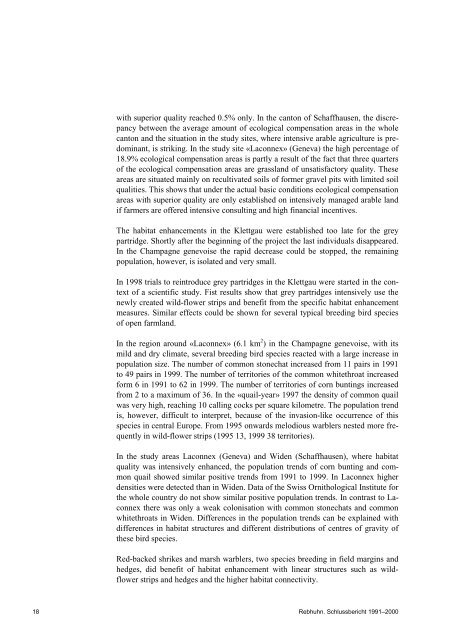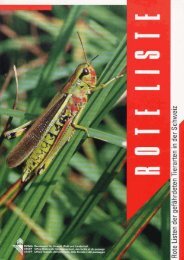Rebhuhn. Schlussbericht 1991–2000 - BAFU
Rebhuhn. Schlussbericht 1991–2000 - BAFU
Rebhuhn. Schlussbericht 1991–2000 - BAFU
Erfolgreiche ePaper selbst erstellen
Machen Sie aus Ihren PDF Publikationen ein blätterbares Flipbook mit unserer einzigartigen Google optimierten e-Paper Software.
with superior quality reached 0.5% only. In the canton of Schaffhausen, the discrepancy<br />
between the average amount of ecological compensation areas in the whole<br />
canton and the situation in the study sites, where intensive arable agriculture is predominant,<br />
is striking. In the study site «Laconnex» (Geneva) the high percentage of<br />
18.9% ecological compensation areas is partly a result of the fact that three quarters<br />
of the ecological compensation areas are grassland of unsatisfactory quality. These<br />
areas are situated mainly on recultivated soils of former gravel pits with limited soil<br />
qualities. This shows that under the actual basic conditions ecological compensation<br />
areas with superior quality are only established on intensively managed arable land<br />
if farmers are offered intensive consulting and high financial incentives.<br />
The habitat enhancements in the Klettgau were established too late for the grey<br />
partridge. Shortly after the beginning of the project the last individuals disappeared.<br />
In the Champagne genevoise the rapid decrease could be stopped, the remaining<br />
population, however, is isolated and very small.<br />
In 1998 trials to reintroduce grey partridges in the Klettgau were started in the context<br />
of a scientific study. Fist results show that grey partridges intensively use the<br />
newly created wild-flower strips and benefit from the specific habitat enhancement<br />
measures. Similar effects could be shown for several typical breeding bird species<br />
of open farmland.<br />
In the region around «Laconnex» (6.1 km 2 ) in the Champagne genevoise, with its<br />
mild and dry climate, several breeding bird species reacted with a large increase in<br />
population size. The number of common stonechat increased from 11 pairs in 1991<br />
to 49 pairs in 1999. The number of territories of the common whitethroat increased<br />
form 6 in 1991 to 62 in 1999. The number of territories of corn buntings increased<br />
from 2 to a maximum of 36. In the «quail-year» 1997 the density of common quail<br />
was very high, reaching 10 calling cocks per square kilometre. The population trend<br />
is, however, difficult to interpret, because of the invasion-like occurrence of this<br />
species in central Europe. From 1995 onwards melodious warblers nested more frequently<br />
in wild-flower strips (1995 13, 1999 38 territories).<br />
In the study areas Laconnex (Geneva) and Widen (Schaffhausen), where habitat<br />
quality was intensively enhanced, the population trends of corn bunting and common<br />
quail showed similar positive trends from 1991 to 1999. In Laconnex higher<br />
densities were detected than in Widen. Data of the Swiss Ornithological Institute for<br />
the whole country do not show similar positive population trends. In contrast to Laconnex<br />
there was only a weak colonisation with common stonechats and common<br />
whitethroats in Widen. Differences in the population trends can be explained with<br />
differences in habitat structures and different distributions of centres of gravity of<br />
these bird species.<br />
Red-backed shrikes and marsh warblers, two species breeding in field margins and<br />
hedges, did benefit of habitat enhancement with linear structures such as wildflower<br />
strips and hedges and the higher habitat connectivity.<br />
18 <strong>Rebhuhn</strong>. <strong>Schlussbericht</strong> <strong>1991–2000</strong>



